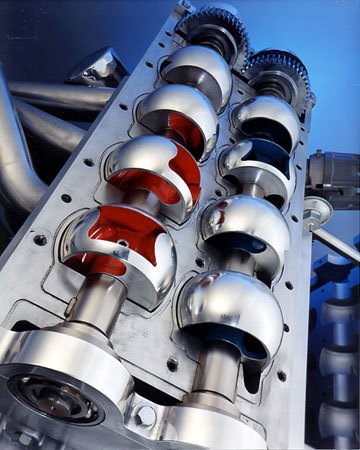Coates Spherical Rotary Valve System – Let the Rivet Counting Begin!
According to the official website, the Coates Spherical Rotary Valve System creates "a quieter engine with higher specific power output and longer life than conventional poppet valve engines due to better 'breathing' capability and higher speed capability." In fact, it's "the single most significant development in engine technology in the past thirty years." Not being the most mechanically-minded pistonhead on the planet, I asked Sajeev Mehta to check it out: "Its a logical extension of innovations like roller rockers: reduced friction, more power, efficiency etc. The general feel I got from people who know more than me: sealing a spherical valve isn't gonna work for a production car. Today's engines have to last over 100k miles without any trouble, and engine "blow by" will be even worse here… and don't even think about pressurizing these valves with a turbo/supercharger/ Good night! As for their claim of their valves not needing oil. Strap on an A/C compressor: sit in traffic in 100 degree weather on a heat-soaked hunk of tarmac and those valves will be begging for extra lubrication. The big red flag for me: their they compared it to a regular engine without an EGR valve. That's like challenging Carl Lewis to a 100m race and making him do it barefoot on hot asphalt. Everyone uses EGR valves for a good reason; they reduce NOx (the third row on their chart) emissions by something like 70% or more. "On the exhaust stroke the poppet exhaust valve stems allow "back" pressure through the valve guides into the engine casing. This pressure is then redirected through the fuel induction system and in turn is reburned in the engine creating yet more hydrocarbons, carbon dioxide and carbon monoxide." Except that happens on high mileage motors with worn valve guides/springs (valves snap shut plenty fine when new). It took 150k miles for my 5.0 Ford to get weaker/slower/dirtier from valvetrain age. Newer engines are even better at valvetrain durability for many reasons. I seriously question if the Coates engine will fare much better after that type of punishment. I'm skeptical, but would change my tune with better info. EPA-style tests that carmakers do wouldn't hurt."
More by Robert Farago
Latest Car Reviews
Read moreLatest Product Reviews
Read moreRecent Comments
- Dartman https://apnews.com/article/artificial-intelligence-fighter-jets-air-force-6a1100c96a73ca9b7f41cbd6a2753fdaAutonomous/Ai is here now. The question is implementation and acceptance.
- FreedMike If Dodge were smart - and I don't think they are - they'd spend their money refreshing and reworking the Durango (which I think is entering model year 3,221), versus going down the same "stuff 'em full of motor and give 'em cool new paint options" path. That's the approach they used with the Charger and Challenger, and both those models are dead. The Durango is still a strong product in a strong market; why not keep it fresher?
- Bill Wade I was driving a new Subaru a few weeks ago on I-10 near Tucson and it suddenly decided to slam on the brakes from a tumbleweed blowing across the highway. I just about had a heart attack while it nearly threw my mom through the windshield and dumped our grocery bags all over the place. It seems like a bad idea to me, the tech isn't ready.
- FreedMike I don't get the business case for these plug-in hybrid Jeep off roaders. They're a LOT more expensive (almost fourteen grand for the four-door Wrangler) and still get lousy MPG. They're certainly quick, but the last thing the Wrangler - one of the most obtuse-handling vehicles you can buy - needs is MOOOAAAARRRR POWER. In my neck of the woods, where off-road vehicles are big, the only 4Xe models I see of the wrangler wear fleet (rental) plates. What's the point? Wrangler sales have taken a massive plunge the last few years - why doesn't Jeep focus on affordability and value versus tech that only a very small part of its' buyer base would appreciate?
- Bill Wade I think about my dealer who was clueless about uConnect updates and still can't fix station presets disappearing and the manufacturers want me to trust them and their dealers to address any self driving concerns when they can't fix a simple radio?Right.


































Comments
Join the conversation
Naw, the "next big thing" will be the return of the Willys-Knight sleeve valve engine!
The latest "Coates HOT OF THE PRESS" China will require - if everything pans out - that all engines will be Coates engines. What next? This should happen in 2 weeks - ad infinitium.